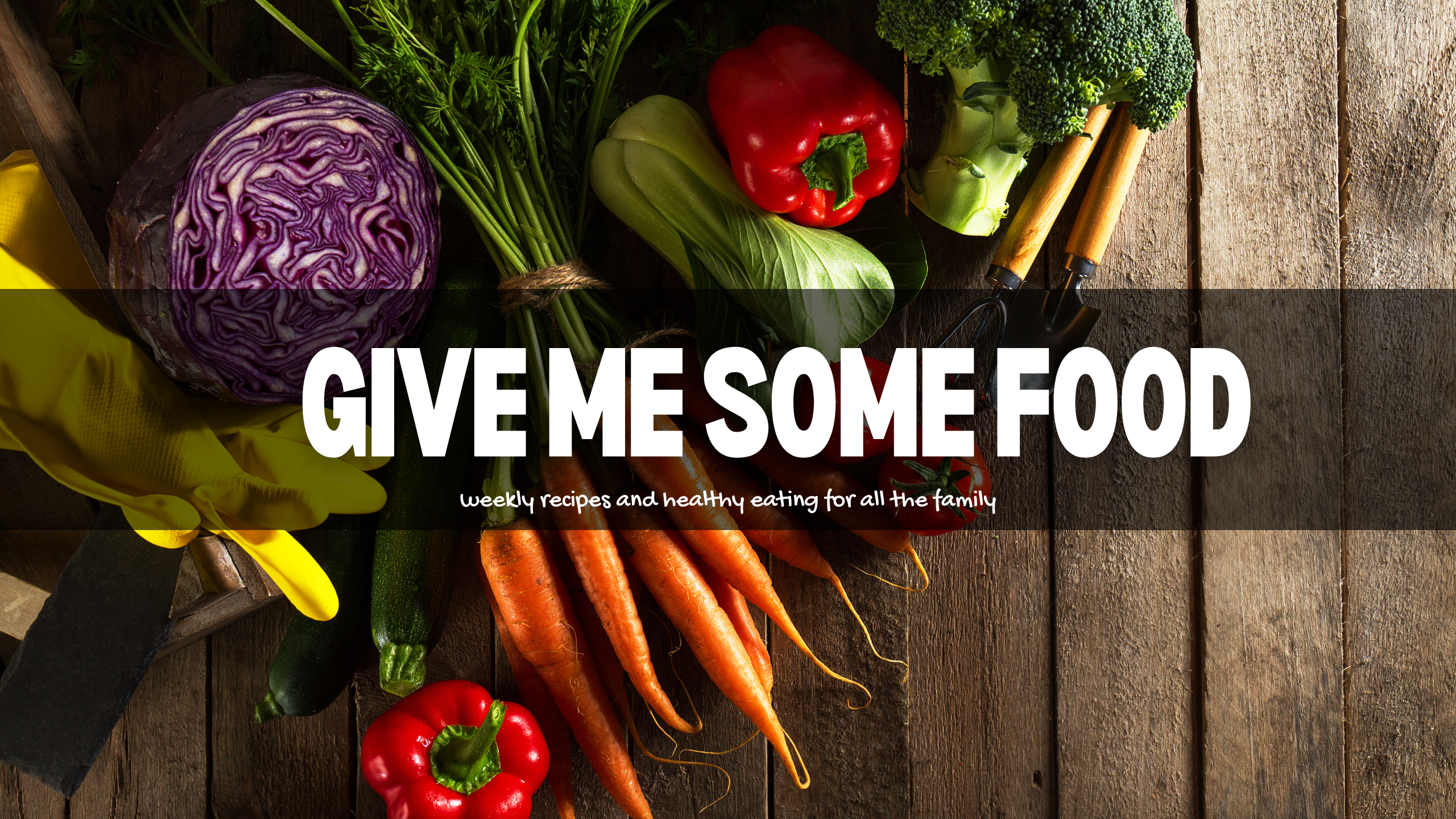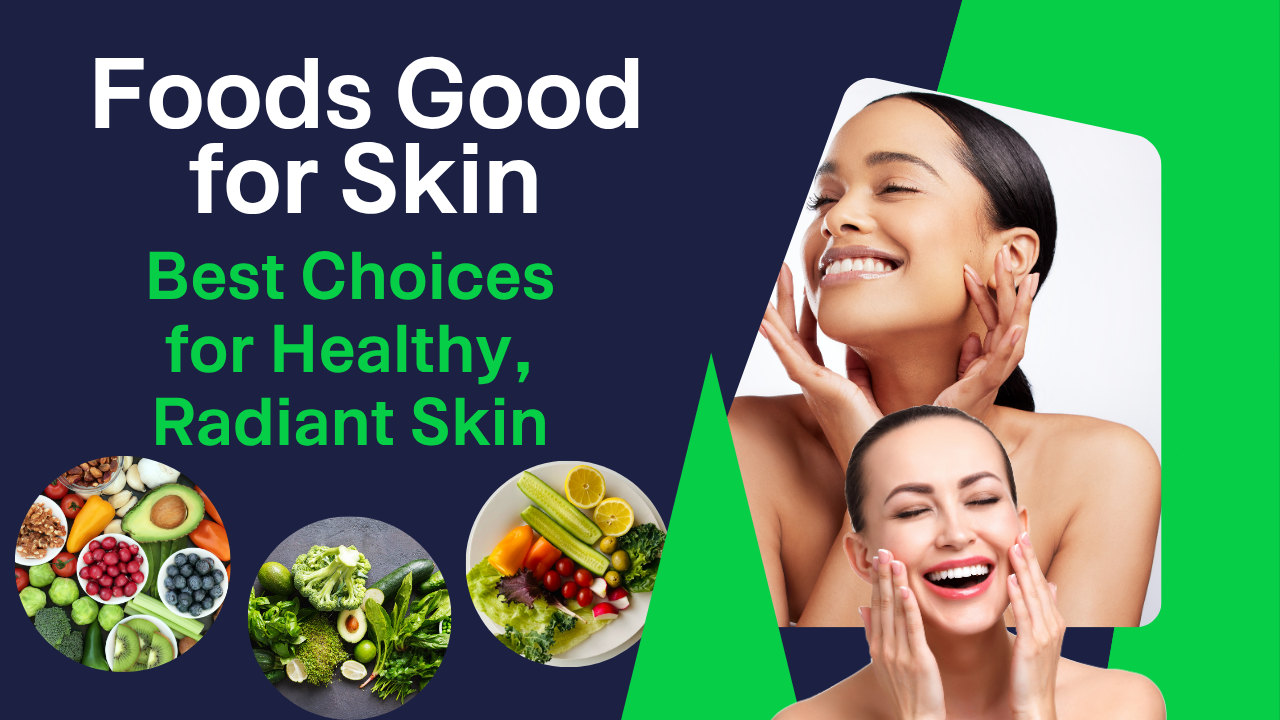The secret to glowing, healthy skin goes far beyond skincare products — it begins with what you eat. Including foods good for skin into your daily diet provides essential nutrients, antioxidants, and healthy fats that your skin needs to repair, protect, and rejuvenate itself. Unlike topical creams that only work on the surface, foods good nourish your skin from the inside out, improving its texture, tone, and overall health. A diet rich in fruits, vegetables, nuts, seeds, and healthy proteins can help reduce dryness, prevent premature aging, and enhance your natural radiance.
Eating the right foods good for skin also helps combat oxidative stress caused by free radicals, UV exposure, and environmental pollutants. Antioxidants from berries, leafy greens, and citrus fruits neutralize harmful molecules that damage skin cells, while omega-3 fatty acids from fatty fish or chia seeds support hydration and reduce inflammation. Vitamins and minerals, such as vitamin C, vitamin E, zinc, and selenium, play a critical role in collagen synthesis, skin repair, and maintaining a strong barrier against environmental stressors.
Incorporating foods good for skin doesn’t have to be complicated. Simple swaps like adding a handful of nuts to your breakfast, enjoying a colorful salad with leafy greens and citrus, or snacking on berries can provide a powerful boost to your skin health. Hydrating fruits and vegetables, such as watermelon and cucumber, help maintain moisture, while probiotic-rich foods like yogurt and kefir support gut health, which is closely linked to clearer, calmer skin.✨
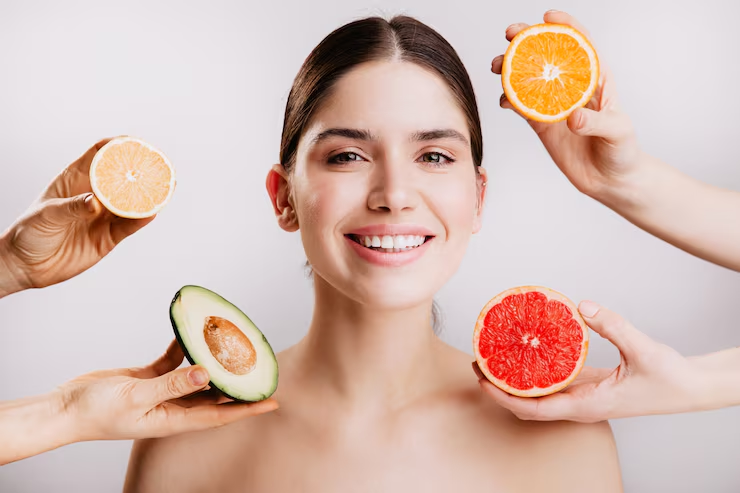
What Are Foods Good for Skin?
When we talk about foods good for skin, we are referring to natural, nutrient-rich foods that nourish your body from within and reflect their benefits outwardly through glowing, healthy skin. These foods good for skin contain essential vitamins, minerals, antioxidants, and healthy fats that strengthen your skin’s structure, enhance its radiance, and protect it from damage. Unlike temporary cosmetic fixes, eating the right foods good for skin helps build long-term resilience by promoting cellular repair and collagen production. For example, foods like berries, citrus fruits, nuts, seeds, and leafy greens are loaded with antioxidants that fight free radicals — the unstable molecules responsible for premature aging, dullness, and fine lines.
Furthermore, foods good for skin go beyond surface-level beauty. They actively contribute to skin protection, hydration, and renewal. Every bite of fruits, vegetables, nuts, and whole grains packed with vitamins A, C, and E helps to improve your skin tone and texture. Vitamin C-rich foods good for skin like oranges, strawberries, and bell peppers help in collagen synthesis, which keeps the skin firm and youthful. Vitamin E-rich foods such as almonds and sunflower seeds act as natural shields against UV damage and oxidative stress. Zinc and selenium, found in foods like pumpkin seeds, lentils, and eggs, promote healing and prevent acne breakouts.
Ultimately, foods good for skin are those that work in harmony with your body’s systems to maintain balance, reduce inflammation, and promote a luminous complexion. Hydrating foods like cucumbers, tomatoes, and watermelon provide water and electrolytes that keep your skin fresh and dewy. Probiotic-rich foods good for skin like yogurt, kefir, and fermented vegetables balance gut bacteria, which in turn helps reduce acne and redness. Whole grains and legumes stabilize blood sugar levels, reducing hormonal acne triggers.
Why Are Foods Good for Skin So Important?
When we talk about foods good for skin, we’re really talking about the foundation of healthy, glowing, and youthful skin from within. Your skin is a reflection of your inner health, and the nutrients you consume play a direct role in how your skin looks, feels, and functions. These foods good for skin provide essential vitamins, minerals, antioxidants, and healthy fats that repair, protect, and renew your skin cells every single day. For instance, antioxidants like vitamin C, E, and beta-carotene found in many foods good for skin help to neutralize harmful free radicals caused by sun exposure, stress, and pollution. Without these nutrients, your skin can become dull, dry, and more prone to premature aging and breakouts.
Moreover, foods good for skin are vital because they help combat inflammation and oxidative stress, two of the biggest enemies of clear and youthful skin. Inflammatory foods such as processed snacks, sugars, and fried items can worsen acne, redness, or eczema, while anti-inflammatory foods good for skin — like fatty fish, leafy greens, nuts, and seeds — help to calm irritation and promote healing. Omega-3 fatty acids from fish like salmon and walnuts keep your skin’s barrier strong and hydrated, preventing dryness and flakiness. At the same time, vitamin C-rich foods like oranges, strawberries, and bell peppers boost collagen production, which keeps your skin elastic and firm.
Lastly, foods good for skin are important because they support the gut–skin connection — a key factor in maintaining clear, balanced skin. A healthy digestive system allows proper nutrient absorption, ensuring your skin receives the nourishment it needs. Probiotic-rich foods good for skin like yogurt, kefir, and kimchi help balance gut bacteria, which can reduce acne and inflammation. Hydrating foods such as cucumbers, watermelon, and citrus fruits maintain moisture levels, while zinc and vitamin A–rich foods repair skin tissue and regulate oil production.
Best Types of Foods Good for Skin (with Examples & Tips)
Fatty Fish and Omega-3 Sources
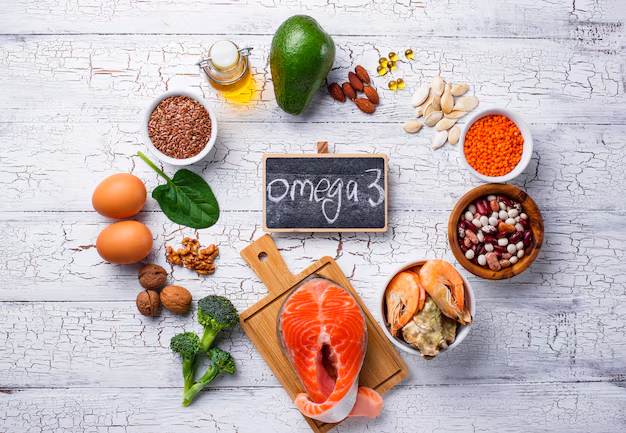
Why they’re beneficial:
Fatty fish (like salmon, mackerel, sardines, trout) are among the most potent foods good for skin due to their high content of long-chain omega-3 fatty acids (EPA and DHA). These fats integrate into skin cell membranes, enhancing flexibility, barrier function, and reducing inflammation. The result: less redness, fewer breakouts, better hydration, and slower aging.
Beyond skin, omega-3s support cardiovascular health, brain function, and mood, making them a holistic choice. The anti-inflammatory effect helps dampen pathways that otherwise accelerate collagen breakdown or promote oxidative stress in skin.
Examples & daily tips:
Grilled salmon fillet (3–4 oz) a few times per week
Sardines on whole-grain toast
Canned mackerel in salads
Flaxseed oil (mixed into smoothies or dressings)
Chia seeds (sprinkled on yogurt, oatmeal)
Balance your intake: aim for at least two servings of fatty fish per week, or incorporate plant-based omega-3 alternatives (chia, flax, walnuts) if you’re vegetarian or vegan. Just be sure to pair them with antioxidants (vitamin E) to prevent oxidation of these fatty acids.
Berries & Colorful Fruits (Antioxidant Powerhouses)
Why they’re beneficial:
Berries and colorful fruits (blueberries, strawberries, raspberries, blackberries, pomegranate, cherries) are loaded with polyphenols, anthocyanins, vitamin C, and flavonoids. These compounds are among the most potent foods good for skin when it comes to neutralizing free radicals, enhancing collagen synthesis, and supporting microcirculation.
Vitamin C in particular is essential for proline/hydroxyproline crosslinking in collagen structures. The other phytonutrients shut down inflammatory signals, protect against UV damage, and even support DNA repair in skin.
Examples & daily tips:
A morning bowl of mixed berries with yogurt or cereal
Blended berry smothies
Fresh cherries or pomegranate seeds as snack
Berry compotes over oatmeal or pancakes
Freeze berries as ice cubes in lemon water
Try to eat a rainbow of fruits daily (aim for “5 colors” rule) — each hue brings a different protective compound. Mixing berries with vitamin C rich citrus further boosts skin benefits.
Leafy Greens & Vegetables
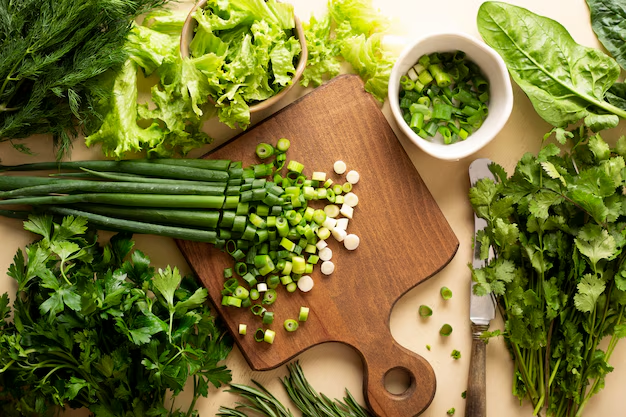
Why they’re beneficial:
Dark leafy greens (spinach, kale, Swiss chard, collards) and colorful vegetables (bell peppers, broccoli, carrots, sweet potatoes) are essential among foods good for skin. They offer a cascade of nutrients: vitamins A, C, K, folate, chlorophyll, and minerals like magnesium and potassium.
These greens protect skin cells through antioxidant activity, promote detoxification via the liver, and supply fiber that supports gut health. Carotenoids (in carrots, sweet potatoes) deposit in the skin, giving a healthy glow and protection against UV stress (a mild, internal “sunscreen” effect).
Examples & daily tips:
Green smoothies (spinach + banana + berries)
Stir-fry of colorful veggies
Roasted sweet potatoes or carrot wedges
Steamed broccoli + kale sauté
Pureed soups of greens or squash
Blend raw and cooked forms — raw for enzyme and vitamin C preservation, cooked for digestibility. Use herbs, garlic, lemon to enhance flavor and nutrient uptake.
Nuts, Seeds & Healthy Oils
Why they’re beneficial:
Almonds, walnuts, pumpkin seeds, sunflower seeds, flax seeds, chia seeds, hemp seeds — plus oils like extra virgin olive oil, avocado oil, and cold-pressed nut oils — constitute potent foods good for skin because they deliver vitamin E, selenium, zinc, essential fatty acids, and phytosterols.
Vitamin E protects cell membranes from oxidation. Zinc supports DNA repair, immune regulation, and oil balance. The healthy fats maintain skin barrier integrity and reduce water loss. Phytosterols help modulate inflammation.
Examples & daily tips:
A handful of mixed nuts as snack
Chia or flax pudding for breakfast
Pumpkin seeds sprinkled on salads
Drizzling extra virgin olive oil on steamed veggies
Avocado oil in salad dressings
Watch portions — nuts are calorie-dense, so aim for a small handful (about 30 g) daily. Rotate varieties to cover diverse nutrients. Combine with fruits/greens for synergy.
Citrus Fruits & Vitamin C–Rich Foods
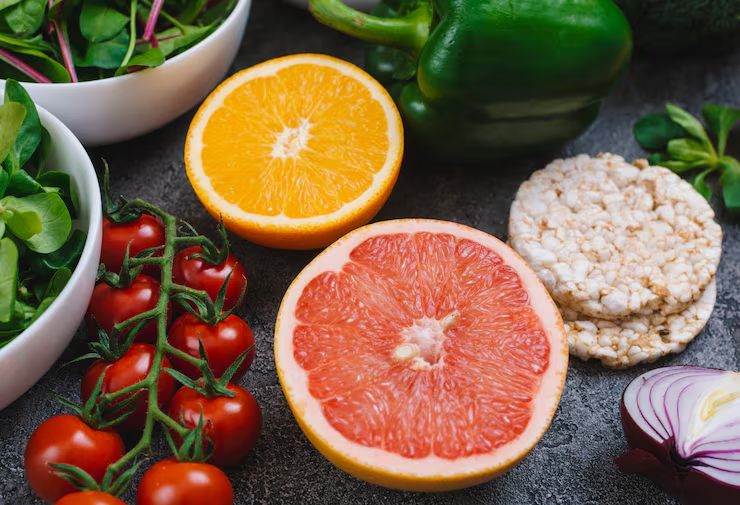
Why they’re beneficial:
Citrus fruits (oranges, grapefruits, lemons, limes), along with kiwis, guavas, strawberries, and bell peppers, are among the most direct foods good for skin when it comes to supplying vitamin C. This vitamin is pivotal for collagen crosslinking, antioxidant recycling, and even melanin regulation (helping brighten skin tone).
Vitamin C rebuilds vitamin E after it neutralizes free radicals, working together as a defense network. It also boosts immune function and supports blood vessels feeding the skin, as well as inhibits enzymes that degrade collagen.
Examples & daily tips:
Fresh orange or grapefruit slices at breakfast
Lemon/lime juice in water or salad dressings
Strawberries as dessert or in yogurt
Red bell peppers in salads or stir-fries
Kiwi or guava slices as snack
To maximize absorption, pair vitamin C with iron sources (e.g. spinach + citrus) and avoid cooking to destruction — gently cook or consume raw when possible.
Probiotic & Fermented Foods
Why they’re beneficial:
Because of the gut–skin axis, foods good for skin include those that foster a healthy microbiome: yogurt, kefir, sauerkraut, kimchi, miso, tempeh, kombucha, and fermented vegetables. These deliver beneficial bacteria (probiotics) and, often, prebiotic fibers that feed them.
A balanced gut microbiota reduces “leaky gut,” systemic endotoxin load, and inflammatory signals that can exacerbate acne, eczema, psoriasis, and rosacea. Furthermore, improved nutrient absorption means your body can better harness all the other foods good for skin you eat.
Examples & daily tips:
Plain yogurt or kefir with berries for breakfast
A side of sauerkraut or kimchi with meals
Miso soup as appetizer
Tempeh in stir-fry or salads
Fermented pickles (naturally fermented, no vinegar)
Choose unsweetened or low-sugar options. Introduce slowly to avoid digestive upset. Rotate fermented foods for microbial diversity.
Whole Grains, Legumes & Fiber Sources
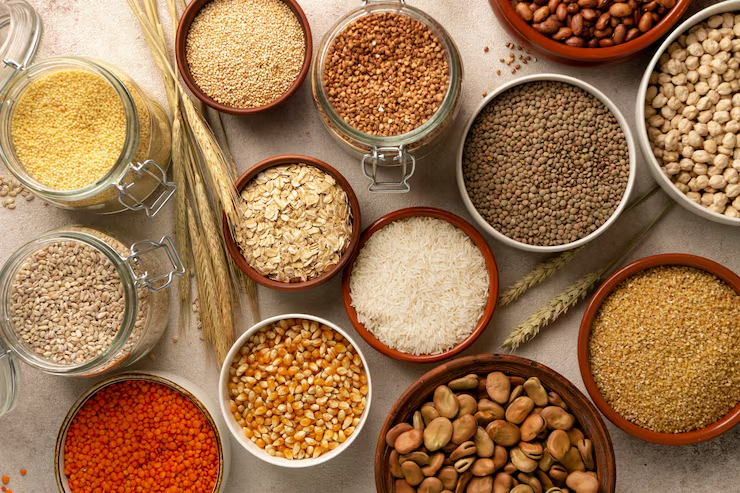
Why they’re beneficial:
Whole grains (oats, quinoa, brown rice), legumes (beans, lentils, chickpeas), and fiber-rich foods (peas, split peas, barley, psyllium) are essential foods good for skin because they stabilize blood sugar, reduce glycemic spikes, and feed gut microbiota. High glycemic diets spike insulin, trigger inflammation, and worsen breakouts or break down collagen.
Fiber supports regular digestion, toxin elimination, and microbial health (via prebiotics). Stable blood sugar helps reduce hormonal triggers that may worsen acne or oily skin.
Examples & daily tips:
Overnight oats with flax and berries
Lentil soup or curry
Brown rice or quinoa bowls with vegetables
Chickpea salad or hummus
Black bean chili
Rotate grains to avoid monotony (rice, barley, millet). Combine with vegetables and proteins for balanced meals.
Hydrating Foods & Water-Rich Fruits/Vegetables
Why they’re beneficial:
Hydration matters. While drinking water is essential, foods good for skin also include water-rich fruits and vegetables (cucumber, watermelon, celery, zucchini, oranges, grapefruit). These deliver water plus vitamins, minerals, and phytonutrients.
Hydration supports skin volume, plumpness, nutrient transport, and toxin removal. When your skin cells are well hydrated, they look fuller, smoother, and less wrinkled. Coupled with barrier lipids from other foods, this helps maintain softness and suppleness.
Examples & daily tips:
Slices of cucumber or celery as snack
Watermelon or citrus salad
Zucchini or summer squash in stir-fry
Cucumber + mint infused water
Tomato or bell pepper salads
Aim to include at least one hydrating food per meal. Combine with electrolytes (e.g. in fruits) to help water retention.
Foods Good for Skin: Top Tips for Healthy, Glowing Skin
| # | Tip / Food Category | Why It’s Good for Skin | Examples | Usage Tips |
|---|---|---|---|---|
| 1 | Fatty Fish & Omega-3 Sources | Rich in EPA and DHA omega-3s, reduce inflammation, support skin hydration, improve elasticity | Salmon, mackerel, sardines, trout | Eat 2–3 times per week; pair with leafy greens for vitamin synergy |
| 2 | Berries & Colorful Fruits | Packed with antioxidants, vitamin C, and polyphenols; neutralize free radicals, support collagen | Blueberries, strawberries, raspberries, cherries, pomegranate | Include in smoothies, yogurt, or as snacks daily |
| 3 | Leafy Greens & Vegetables | Provide vitamins A, C, K, and minerals; promote detox, reduce oxidative stress, improve glow | Spinach, kale, Swiss chard, broccoli, carrots, sweet potatoes | Eat raw in salads or lightly cooked to retain nutrients |
| 4 | Nuts, Seeds & Healthy Oils | Supply vitamin E, zinc, selenium, and essential fatty acids; strengthen skin barrier, prevent dryness | Almonds, walnuts, pumpkin seeds, sunflower seeds, flax seeds, olive oil | Small handful daily; drizzle oils on salads or cooked dishes |
| 5 | Citrus Fruits & Vitamin C-Rich Foods | Boost collagen production, protect against UV damage, improve skin tone | Oranges, grapefruits, lemons, kiwis, bell peppers, guava | Eat raw or lightly cooked; pair with iron-rich foods for better absorption |
| 6 | Probiotic & Fermented Foods | Improve gut health, reduce inflammation, support clearer skin | Yogurt, kefir, kimchi, sauerkraut, miso, tempeh | Include 1–2 servings per day; choose unsweetened or low-sodium options |
| 7 | Whole Grains, Legumes & Fiber | Stabilize blood sugar, reduce acne triggers, support gut microbiome | Oats, quinoa, brown rice, lentils, chickpeas, beans | Combine with vegetables and proteins; rotate grains for variety |
| 8 | Hydrating Foods & Water-Rich Produce | Maintain moisture, flush toxins, keep skin plump and dewy | Cucumber, watermelon, celery, zucchini, tomatoes, citrus fruits | Include in every meal; pair with electrolyte-rich foods for optimal hydration |
Conclusion
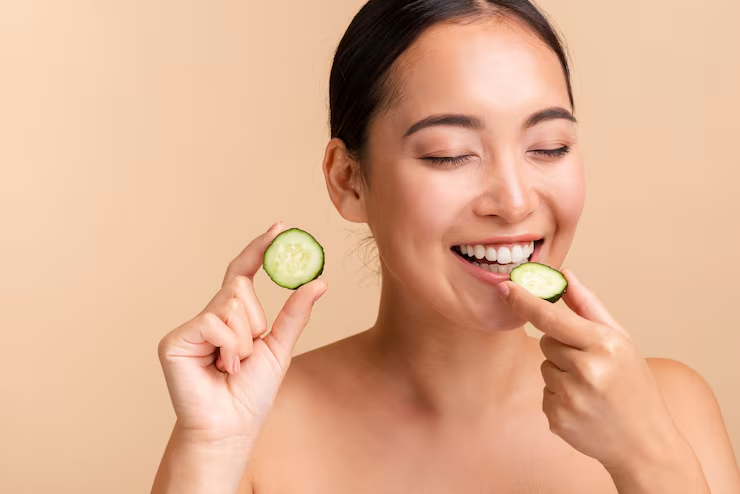
In conclusion, building radiant, healthy skin from the inside out is entirely within your reach — with deliberate choice of foods good for skin. When you consistently nourish your body with antioxidant-rich fruits, omega-3 fatty acids, leafy greens, nuts and seeds, hydrating produce, probiotics, and fiber sources, you supply your skin with everything it needs to rebuild, protect, and glow.
The eight categories we covered — fatty fish and omega-3s; berries and colorful fruits; leafy greens and vegetables; nuts, seeds, and healthy oils; citrus and vitamin C foods; probiotic/fermented foods; whole grains/legumes; hydrating water-rich foods — each bring unique and synergistic benefits. By weaving these into your diet, you construct a comprehensive internal skincare routine.
As you adopt the lifestyle of eating foods good for skin, remember: consistency is key. Results accumulate over time — you may not see every effect overnight, but your body and skin will thank you with more resilience, less inflammation, more natural glow, and a firmer, more supple complexion. Carry this knowledge forward, experiment with delicious recipes, and remember: your journey to better skin is as beautiful as the destination.
FAQs
Q1: What are the most impactful single foods to eat daily among the foods good for skin?
If I had to pick, fatty fish (like salmon) and berries would top the list — they provide potent omega-3s and antioxidants. However, combining nuts/seeds for vitamin E, citrus for vitamin C, and greens for carotenoids maximizes synergy. A daily smoothie with spinach + berries + flax + yogurt hits multiple of the foods good for skin in one go.
Q2: Can I get all the benefits of foods good for skin through supplements alone?
Supplements can help in deficiency, but whole foods deliver complex matrices of phytochemicals, fiber, interactions, and synergy that supplements can’t fully replicate. Over-reliance on supplements may miss gut-skin interactions, absorption dynamics, and co-nutrients present in foods good for skin.
Q3: How long before skin improvements become visible when I include foods good for skin?
Generally, you may notice subtle changes (radiance, reduced dryness) within 4–6 weeks. Structural improvements (firmer skin, fewer fine lines) may take 3–6 months, because collagen synthesis and cellular turnover operate over longer cycles. Consistency matters most.
Q4: Are there foods I should avoid that counteract the benefits of foods good for skin?
Yes — highly processed foods, refined sugars, trans fats, excessive dairy or high glycemic carbs may promote inflammation and oxidative stress. Alcohol and excessive caffeine dehydrate the skin. These can offset gains from your foods good for skin.
Q5: Can these foods help with specific skin issues like acne, eczema or rosacea?
Yes — many foods good for skin have anti-inflammatory, antioxidant, barrier-support, and microbiome benefits that can help calm acne, reduce flare-ups in eczema, and lower redness in rosacea. But they’re supportive, not replacements for medical treatments when needed. Always pair with dermatologist guidance for severe cases.
